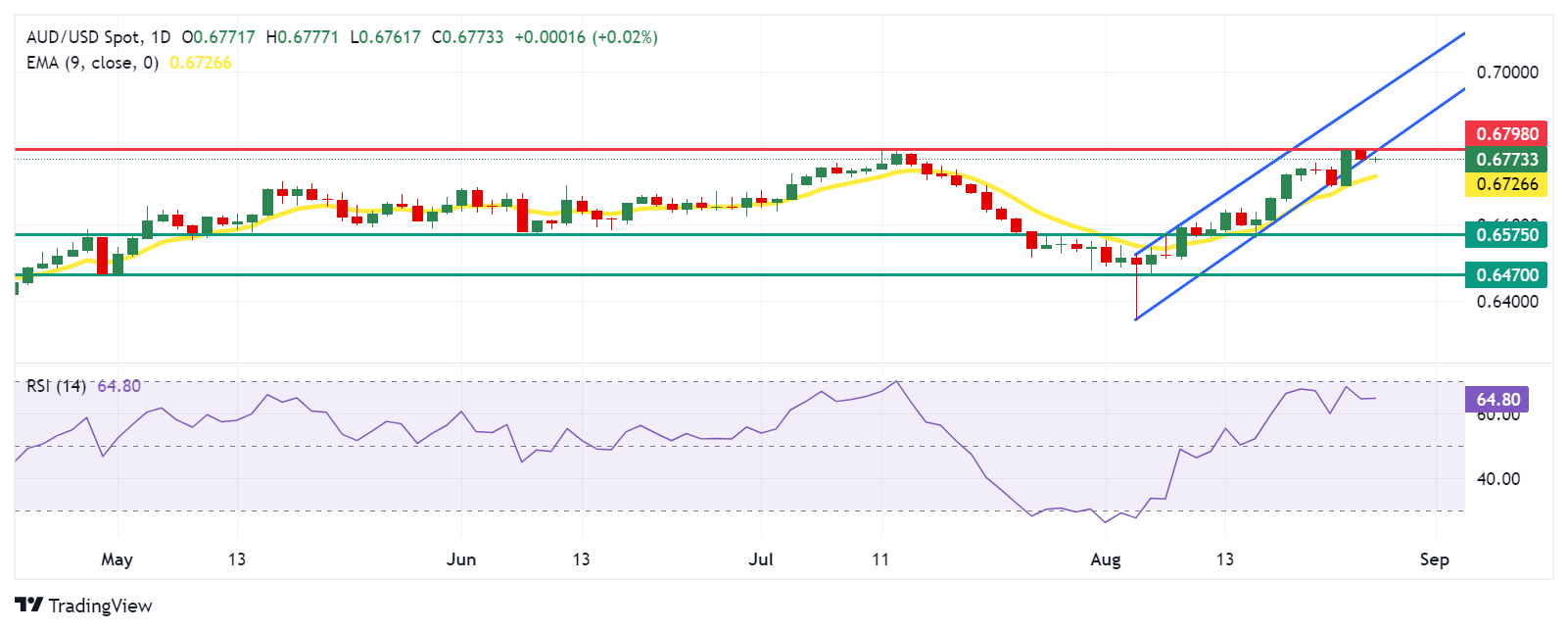Australian Dollar moves sideways around seven-month highs


- The Australian Dollar holds ground as the RBA is highly expected to adopt a hawkish stance regarding its policy outlook.
- The Aussie Dollar may advance further as RBA minutes indicated that a rate cut is unlikely soon.
- The US Dollar received downward pressure as the Fed Chair Powell signaled a rate cut soon.
The Australian Dollar (AUD) moves sideways against the US Dollar (USD) on Tuesday, holding a position just below the seven-month high of 0.6798 recorded on Monday. However, the downside of the AUD/USD pair would be limited as traders expect different policy outlooks between the two central banks.
The recent Reserve Bank of Australia (RBA) Minutes showed that the board members agreed that a rate cut is unlikely soon. Additionally, RBA Governor Michele Bullock expressed that the Australian central bank will not hesitate to raise rates again to combat inflation if needed.
The US Federal Reserve (Fed) Chairman Jerome Powell stated at the Jackson Hole Symposium on Friday, "The time has come for policy to adjust." However, Powell did not specify when rate cuts would begin or their potential size.
According to the CME FedWatch Tool, markets are fully anticipating at least a 25 basis point (bps) rate cut by the Federal Reserve at its September meeting.
Daily Digest Market Movers: Australian Dollar holds ground amid a hawkish RBA
- San Francisco Federal Reserve President Mary Daly stated on Monday in an interview with Bloomberg TV that "the time is upon us" to begin cutting interest rates, likely starting with a quarter-percentage point reduction. Daly suggested that if inflation continues to slow gradually and the labor market maintains a "steady, sustainable" pace of job growth, it would be reasonable to "adjust policy at the regular, normal cadence."
- US Durable Goods Orders surged by 9.9% month-over-month in July, rebounding from a 6.9% decline in June. This increase significantly outpaced the expected 4.0% rise, marking the largest gain since May 2020.
- Bloomberg reported on Friday that Philadelphia Fed President Patrick Harker emphasized the need for the US central bank to lower interest rates gradually. Meanwhile, Reuters reported that Chicago Fed President Austan Goolsbee noted that monetary policy is currently at its most restrictive, with the Fed now focusing on achieving its employment mandate.
- The US Composite PMI dipped slightly to 54.1 in August, a four-month low, down from 54.3 in July, yet remained above market expectations of 53.5. This suggests that US business activity continues to expand, marking 19 straight months of growth.
- Australia's Judo Bank Composite Purchasing Managers Index (PMI) rose to 51.4 in August, up from 49.9 in July. This increase marks the fastest expansion in three months, driven by a stronger performance in the services sector, despite a more pronounced contraction in manufacturing production.
- FOMC Minutes for July’s policy meeting indicated that most Fed officials agreed last month that they would likely cut their benchmark interest rate at the upcoming meeting in September as long as inflation continued to cool.
- On Tuesday, the RBA Minutes suggested that the board members had considered a rate hike earlier this month before ultimately deciding that maintaining current rates would better balance the risks. Additionally, RBA members agreed that a rate cut is unlikely soon.
Technical Analysis: Australian Dollar remains below 0.6800
The Australian Dollar trades around 0.6770 on Friday. Daily chart analysis shows the AUD/USD pair has breached below the ascending channel, suggesting a weakening of a bullish bias. However, the 14-day Relative Strength Index (RSI) remains below the 70 mark, supporting the ongoing bullish trend.
In terms of resistance, the AUD/USD pair tests the immediate barrier at the seven-month high of 0.6798 level, followed by the lower boundary of the ascending channel at 0.6800 level. A break above this level could lead the pair to explore the region around the upper boundary of the ascending channel at the 0.6940 level.
On the downside, the AUD/USD pair may find support around the nine-day Exponential Moving Average (EMA) at the 0.6726 level. A break below the nine-day EMA could weaken the bullish bias and put downward pressure on the pair to navigate the region around the throwback level at 0.6575, followed by another throwback level at 0.6470.
AUD/USD: Daily Chart






